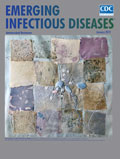
Volume 25, Number 1—January 2019
Etymologia
Etymologia: Penicillin
On This Page

Figure. Two conidiophores of Penicillium frequentans fungi, also known as P. glabrum. The conidiophore is the stalked structure whose distal end produces asexual spores (conidia) by budding. Original magnification x1,200. Photo: CDC/Lucille Georg/1971.
In 1928, while studying Staphylococcus bacteria at Saint Mary’s Hospital in London, Alexander Fleming noticed that one of his petri dishes was contaminated with mold, which was causing the bacteria near it to lyse. Because the mold was identified as belonging to the genus Penicillium (Latin for “brush,” referring to the chains of conidia that resemble a paintbrush or broom), Fleming named the antibacterial substance penicillin (Figure).
Among the earliest known clinical uses of penicillin was by Cecil George Paine, a pathologist at the Sheffield Royal Infirmary, who successfully used it in 1930 to treat gonococcal conjunctivitis in neonates. Thereafter, the therapeutic potential of penicillin went largely unexplored until 1940, when a team of researchers headed by Howard Florey and Ernst Chain showed that it produced dramatic improvements in mice with streptococcal infections. Penicillin was instrumental in treating infections in Allied soldiers in World War II; however, shortly thereafter, resistance became a substantial clinical problem.
References
- Petri WA Jr. Penicillins, cephalosporins, and other β-lactam antibiotics. In: Brunton LL, Chabner BA, Knollmann BC, editors. Goodman and Gilman’s the pharmacological basis of therapeutics. 12th ed. New York: McGraw Hill; 2011. p. 1477–503.
Figure
Cite This ArticleOriginal Publication Date: 11/14/2018






















.png)











No hay comentarios:
Publicar un comentario